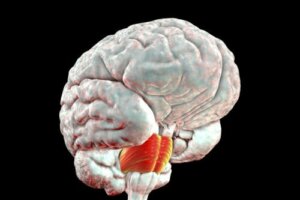Pons Varolii: Characteristics and Functions

The pons, also known as the pons Varolii, is a part of the brain in humans and other bipeds. It lies in front of the cerebellum, above the medulla oblongata, and just below the midbrain. It is, therefore, a structure of the central nervous system (CNS) with its own functions.
Although we can’t understand the function of the cerebrum in isolation, as this organ functions as a whole, several specific activities have been attributed to this area. It’s named after Costanzo Varolio (1543-1575) and emulates a highway that allows permanent communication between the brain and the spinal cord. Let’s see everything you should know about it.
Structure of the pons Varolii

The pons Varolii is located in the brainstem. It shares its location with other areas such as the midbrain and the medulla oblongata. We can functionally divide its structure into the following parts:
- Basilar part of the pons: This is also known as the basilar sulcus or ventral area. The basilar artery crosses through this area, which is the artery that provides oxygenated blood to the brain. It’s located in the middle area of the pons and the damage associated with it is related to alterations in motor functioning.
- The dorsal part of the pons: This is also known as the pontine tegmentum. It’s the anterior area of the pons, which forms a rhomboid structure together with the dorsal medulla. Many motor functions are regulated in this section, as well as sensory and excitatory functions.
Read also: Characteristics and Function of Neurons
This is a general view of the structure, but if we analyze it in a more detailed way we find different tracts or nuclei. Among the most important we can highlight the following:
- Special trigeminal motor nucleus: This regulates proprioception of the periodontal tissues and all masticatory muscles. It also regulates visceral movements.
- Special motor nucleus of the facial: Characterized by a gray mass on the pons.
- Abducens somatic motor nucleus: A structure related to the abducens nerve. It provides innervation to the lateral rectus muscle, one of the extraocular muscles.
- Superior salivary nucleus: Provides parasympathetic innervation to different glands associated with the oral cavity (salivary, submandibular, and sublingual).
It also has other sections such as the vestibular and cochlear nuclei, the nucleus of the solitary tract, the trigeminal pontine nucleus, and many more. All these nuclei are associated with the cranial nerves.
In turn, we can divide its structure into three main groups: the sensory system, the visceral motor system, and the vegetative system. What we can see from this is that it’s a very complex structure, and one that also has a leading role.
Characteristics of the pons
Like many areas of the brain, the pons has some peculiar characteristics. Let’s take a look at some of the ones that often go unnoticed when understanding its functions and structure:
- On average, the pons is only 2.5 centimeters (1 inch) long.
- It’s the bulkiest part of the brainstem (which is partly why it’s known as the pons, which means “bridge”).
- It’s composed of neurons and glia, although some specific areas lack synapses.
- Its proper nuclei are found in the ventral area of its structure, although most of its nuclei are associated with the cranial nerves (they’re external or shared).
- It’s shaped like a thick roller.
- It can be affected by conditions such as central pontine myelinolysis and Millard-Gübler syndrome.
The pons is part of the central nervous system (CNS) and directly and indirectly regulates different functions. Let’s take a look at some of these functions in order to understand its importance more clearly.
Don’t miss this article: 7 Habits that Support Brain Cell Regeneration
Functions of the pons
We’ve already mentioned some of the functions of the pons, but now we’ll describe them more carefully. It isn’t a single area that serves a single function, but, rather, it connects with many other areas to form a whole.
Serves as a communication link
The best-known function of the pons is to serve as a communication link. The pons allows information to flow from the brain to the spinal cord (and vice versa). Thus, it has a regulatory or conductive function. Imagine it as a great highway that functions as a two-way communication pathway.
Regulates automatic functions
On a daily basis, you carry out automatic activities that go completely unnoticed by your consciousness. For example, standing up, breathing, or blinking. The pons is responsible for regulating these and other associated processes. Walking, stopping or resuming inhalation, focusing your eyes on a specific place, and many others.
It’s involved in the expression of emotions and feelings

Emotions such as joy, anger, or sadness are manifested through specific facial features. Thanks to the regulation of the nerves that pass through the pons, these expressions can be controlled, although most of the time it’s done automatically.
Helps maintain balance
Balance is something that most people take for granted. This is because it’s regulated by different systems, including the processes that the pons carries out. These receive and transmit signals to the nerves that allow you to hold your head up or walk without losing your balance.
It’s also involved in your perception of pain, taste, touch, saliva secretion, tears, auditory perception, and many more. As we’ve already pointed out, these functions aren’t developed exclusively in this area, but are combined with other areas of the brain to process as a whole.
So, as you can see, the pons Varolii is a vital part of our brains, and one which is involved in a vast array of functions. We hope you enjoyed learning about it!
All cited sources were thoroughly reviewed by our team to ensure their quality, reliability, currency, and validity. The bibliography of this article was considered reliable and of academic or scientific accuracy.
- Zago S, et al. Costanzo Varolio (1543–1575). Disponible en: https://link.springer.com/article/10.1007/s00415-009-5192-5.
This text is provided for informational purposes only and does not replace consultation with a professional. If in doubt, consult your specialist.








